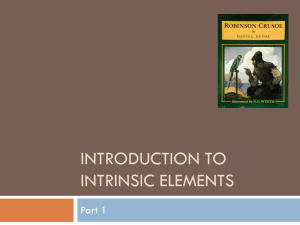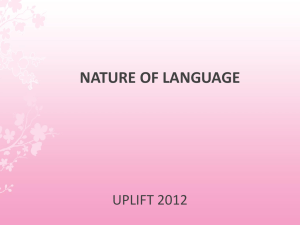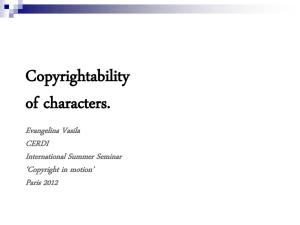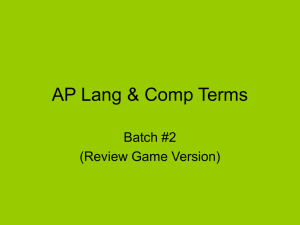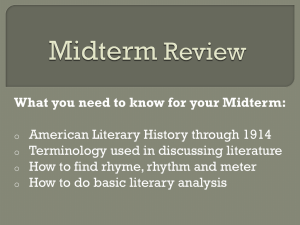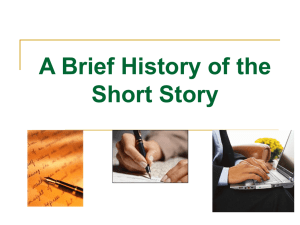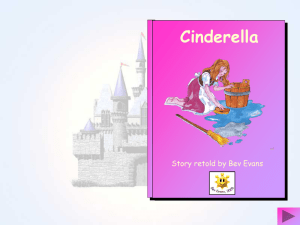************"***************S*******************t*******u*** 3
advertisement
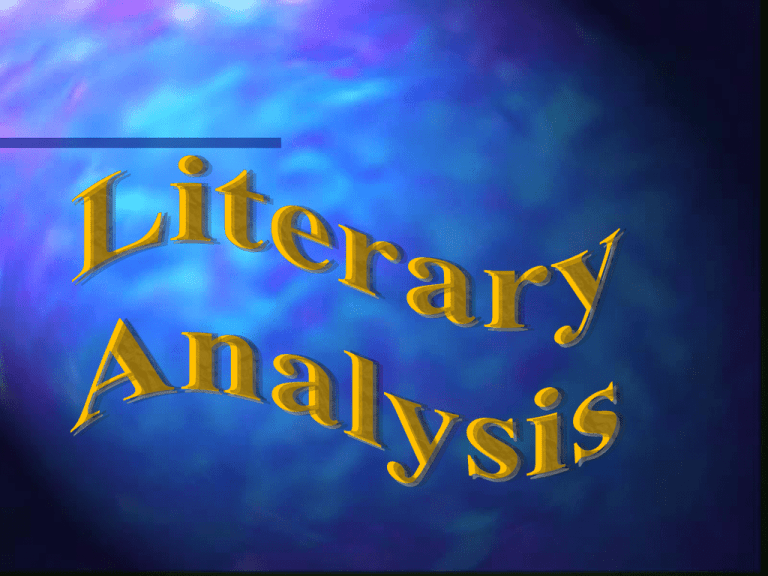
OBJECTIVES Define literary analysis Understand purpose of literary analysis Understand the components of good writing: depth, complexity, quality Tips for effective analysis Analysis of Literary Elements: diction, conflict, character, images, symbols, figurative language, theme and form/style LITERARY ANALYSIS A literary analysis explains a literary work in a formal essay. The work (novel, short story, or poem) is described by the use of the literary elements and the intention of the author. LITERARY ANALYSIS Literary analysis assumes knowledge of the work and therefore does not provide a summary. Each analysis paper supports a clearly defined thesis to be proved about the work; it is PERSUASIVE. PURPOSE OF ANALYSIS The ultimate end of analysis is a deeper understanding and a fuller appreciation of the literature – you learn to see more, to uncover or create richer, denser, more interesting meanings. YOU MIGHT BE ASKING--- To begin to analyze written work a common way of identifying the qualities that characterize it as 'good' by examining its …. When we are looking deeply into the text we see that we are formed largely by culture we have common human needs (Remember: Maslow’s Hierarchy of Needs?) we experience life with complexity our lives hold symbolic and historical meaning When you read remember that authors are demonstrating to us that there is more to life than our physical sense of it. Authors seek to define some of the forces and feelings which give importance to our being. Think in terms of our human experience as: being made up by interacting factors -environment, character, situation and so forth, and comprised of a number of different elements - thought, feeling, sensation, memory, imagination, significant symbols, culturallyformed ways of saying and thinking. Our experience is complex. In order to suggest the complexities and the depth of experience, literature has to use all of its resources well. The more the resources of language and meaning are used to reveal the depth and complexity the more we say this work has QUALITY. STRATEGIES TO FOLLOW FOR EFFECTIVE ANALYSIS Read the text Consider related viewpoints Consider literary elements Quick Tips Political Critical viewpoint viewpoint: consider how political systems and politics are portrayed in the work; Feminist viewpoint: consider how the work portrays women and approaches gender roles; Ethnic viewpoint: consider how ethnic groups are portrayed within the work Quick Tips Critical viewpoint Consider other perspectives where appropriate religious psychological belief systems The caution here is to accurately represent the text and support all interpretations by evidence in the text. First…. and read the novel. Take notes along the way, considering the literary elements while you read Literary Elements CHARACTER Consider what consistent qualities the character has, what motivates the character, what complexities the character shows, does the character change or remain the same. Are the characters dynamic, static, round or flat? Character Types • Flat Characters: one-sided or less developed characters. These characters are usually minor characters or represent something stereotypical. •Round Characters: are multi-dimensional and are usually the protagonist. These are more developed characters and seem more real. •Dynamic Characters: are characters who go through a significant change in the story. The protagonist is usually a dynamic character. •Static Characters: are characters who do not change throughout the story. •When we discuss character types, we look for qualities that are: •Physical – hair color, physical description •Implied/Inferred – these are characteristics about their personality (shy, funny, racist, amiable) Character Types • In the story Cinderella, how would you describe these characters? •The Prince • Flat and Static •Cinderella • Round and Dynamic •The Evil Stepmother •Flat and Static •In describing Cinderella, the writer might say: •Cinderella is a beautiful, young woman with blonde hair (physical). She is sweet and kind (implied). She is the protagonist of the story and is a round, dynamic character. Literary Elements DICTION Focus on THE WORDS of the work. Ask: Is the language clear or does the author use metaphors and similes? Is this the language of emotion or reason? What images are created? How has dialogue been used? Does it add meaning to the novel? CONNOTATION Analyze the figures of speech and sound effects of the work. These elements add to the meaning. Literary Elements CONFLICT List all of the conflicts or tensions in the work and fill them out with examples or evidence from the work Draw conclusions about the conflict. Consider the universal ideas of conflict: •Man vs. Man •Man vs. Nature •Man vs. Society •Man vs. Self •Man vs. Religion •Man vs. Machine •Man vs. Supernatural THEME As you already know, theme is the central idea or message the author is sharing with the reader. It does not make a judgment. For example: “Drugs are bad” is not a theme. It merely states something that is true about life and the human condition. Your theme is the opinion component of your thesis statement. Literary Elements THEME Look for the meaning in the text, but don’t settle for the first thing you see. Make a list of all possible themes stated in complete sentences and in universal terms Example: One theme of “The Pearl” is that greed can be a destructive force. How do I find the THEME? Read the entire novel. Consider the literary elements. What message are the literary elements trying to convey to the reader? What is the author trying to say about life? Literary Elements FORM/STYLE Poetry is examined through rhyme, rhythm, sound devices, and format Each genre or type of literature has its own principles of style and form. Fiction is examined by considering narrative point of view, setting, word choice or characterization. Drama’s unique element is staging, the props, actors’ gestures, lighting, the set, and visual effects. ATTITUDE Tone is the attitude of the speaker toward the novel. Literary Elements IMAGES Most literature can be analyzed through images and symbols. Scan the work, listing images, symbols, searching for patterns and repetitions. Write down page references and your first interpretations. REFERENCES Bauman, M. G. (2007). Ideas & details: A guide to college writing. Massachusetts: Thomson Wadsworth: 273-307. Images from Microsoft Office 2003 clipart Knott Poetry Analysis Using TPCASTT retrieved on January 25, 2008 from images.schoolinsites.com/.../BakerHigh/Uploads/Presentat ions/Poetry%20Analysis%20Using%20TPCASTTknott.ppt Lye, J. (2000). Critical reading: A guide. Retrieved August 15, 2003 from http://www.brocku.ca/english/jlye/criticalreading.html Poetry explications. (2007). The Writing Center. University of North Carolina at Chapel Hill. Retrieved on January 17, 2009 from http://www.unc.edu/depts/wcweb/handouts/poetry-explication.html Quotations about Poetry, (2008). The Quote Garden: A Harvest of Quotes for Word Lovers Retrieved on January 30, 2008 from http://www.quotegarden.com/poetry.html Quick Tips Reading Read s l o w l y, p a y a t t e n t i o n to every word Use your gut (initial) reactions Take notes on your impressions and observations Try to discover the author’s purpose-research what the authors have said about their work or historical events that relate to the work
